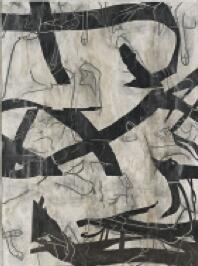Arturo Herrera
Americas Society, New York
In Les Noces (The Wedding), 2007, the viewer witnesses a fragmentary projection of abstract shots following one another to the rhythm of Igor Stravinsky’s music. The ballet, whose music Stravinsky scored in 1923 for Sergei Diaghilev ́s Les Ballet Russes using intertwined fragments of wedding marches which referenced Russian folklore but without following a linear narrative sequence and whose choreography comprised almost mechanical move- ments, was one of the most important modernist experiments of search for the total or the universal work of art (gesamtkunstwerk).

In his first production incorporating moving images, Arturo Herrera recovers that tradition, thereby emphasizing his interest in the legacy of abstraction and the history of modernism. Utilizing fragments of black-and-white photographs of his own works (mainly drawings and collages), which he interlinks with images culled from different sources, Herrera generates eighty images set to Stravinsky’s music and projected randomly. Thus, the images controlled by a computer program that organizes them randomly in response to the pitch of Les Noces, will be projected successively onto two opposing dual screens, never becoming fully synchronized with the composer’s music. In this way, there is a particular disruption between image and sound, which references both the changing nature of dance (no dance can ever be performed exactly the same way twice) and the transformative potential of collage. Indeed, the nonrhythmic movements of the images and the coexistence of differentiated fragments suggest a particular reading of fragmentation that hints at a critical dialogue with the legacy of modernism. The show also includes a variety of works by the artist that inquire into the vibrant potential of abstraction and fragmentation.





